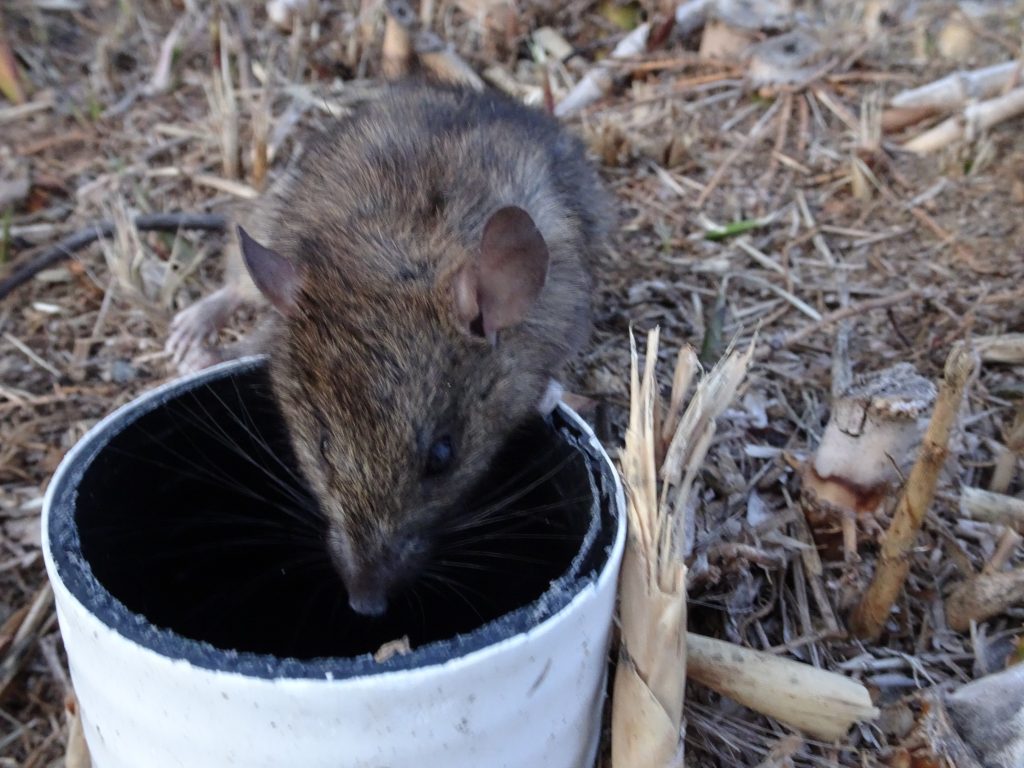Some people find rats adorable and keep them as pets. However, if they are self-invited and unwanted guests, you won’t want them nesting in your home.
There are several different methods of rat control, with varying degrees of effectiveness, including repellents, traps, and poison. Before employing any means of pest control, however, you must understand how they work. Some can be inhumane or have an impact on wildlife beyond the rats.
For more information on the different means of rat control, and how to employ them, read on.
Getting rid of rats can be a time-consuming task, particularly if they have a nest of young, as you will need to access the space to remove them. When in doubt, it’s best to call in a wildlife removal professional to handle it for you.
EXCLUSION
If you have one family of rats living in your home, then more will follow. Don’t just get rid of the rats; find their access points and seal them up. Make sure that the repairs are done correctly and include steel (even as a mesh). Otherwise, rats will find the weak points and chew their way back in.
- Remove any debris or woodpiles around your yard that the rats can use to shelter their nests.
- If you have hedges or shrubs, trim them so that the area around the base is exposed.
- Clear away any food scraps, including any pet food bowls.
- Store food in airtight containers that the rat can’t chew through.
- Keep your trash bins tightly sealed.
RAT TRAPS
There are a variety of rat traps available on the market:
- Snap traps are activated when the rat takes the bait, snapping the rodent’s neck. It doesn’t always kill the animal instantly, though, and leaves you to deal with a dead (or dying) rat.
- Live traps allow you to safely relocate the rat rather than kill it. Set bait at the back of the cage on the activation plate. When triggered, the cage door will shut behind the rat, trapping it.
- Glue traps are perhaps the most inhumane of all traps. It doesn’t kill the animals outright; it merely holds them in place until they die of dehydration or starvation. If you use a glue trap, check it regularly, and be prepared to kill the captured rat humanely with a single, sharp knock to the head.
POISON
Although available commercially, rodenticide isn’t a very effective measure against rats. Poisons can take time to kill the rodent. It may then be eaten by a predator, passing the poison and its effects on. Poison won’t kill all of the rats, and the ones it does kill are most likely to die where you can’t get to them, such as between walls. If this happens, you will have to deal with the smell and carcass of a dead, decaying rat in your home. To learn more about rat poison here is a great source to look at www.ratpoisonfacts.org

Damage That Rats Do to Your Home
Rats are among the most common household pests and can be responsible for a great deal of damage to your home. They are most likely to be found during the winter months when they seek the warmth of a home.
Precise Exterminating Service, Inc. has extensive experience in handling rats, but it is important to understand what damages rats can cause and why you should call a professional as soon as you spot one in your home.
Electrical
Chewed electrical wires in the home pose a serious risk. Rats need to chew often to keep their teeth sharp and manageable. Because wires are small and often in the vicinity of where rats like to roam, they are the perfect target for these furry creatures.
Unfortunately, chewed wires can easily go unnoticed until they cause a larger issue, like an electrical short or fire. Always keep loose cords securely wrapped or covered as a preventative measure.
It is not quite as simple to prevent damage to major electrical wires within your walls, so keep a close eye out for signs of rats so that you can stop the problem quickly and avoid electrical problems.
Structural
Wild rats are not as small as the ones kept as pets but are still easily able to fit through very small holes or gaps to enter your home. They prefer the small, warm areas of attics, crawlspaces, and inside of walls to make their nests. Rats in these spaces can easily go unnoticed for long periods of time.
If you hear movement in your walls or see rat droppings in any part of your home, you need to call a professional immediately to evaluate the presence of rats and determine the best treatment options.
If left unattended, rats can chew through walls, foundations, and insulation. They leave waste and urine behind, which soak into and destroy wood. Repairing these problems is pricey and involved. Precise Exterminating Service, Inc. includes cleanup as part of rat eradication services.
Because they populate very quickly, there is often more than just one rat. A lone rodent can do enough damage, so you will want to catch the problem before more can effectively destroy your home from the inside out.
Personal Property
Similar to the way rats chew through wood and concrete foundations, they also will find ways into your rooms, bathrooms, and kitchen, taking items back to their nests for use as bedding.
Rats also scavenge for food, often finding access into kitchens from beneath counters or within walls. It is common for rodents to chew through cardboard cereal boxes and other containers and eat the contents. It is unsanitary and often messy to clean up.
Books, papers, clothes, and furniture are all vulnerable to rat destruction. Most personal items ruined by rodents are best thrown out, even if left relatively unscathed, because of the diseases rats spread, especially through feces and urine.
Solutions and Prevention
Luckily, pest removal experts are well-equipped to handle rat infestations using a variety of methods. It is easy to think that a little rat poison bought from your local store will solve the problem, but poisons are often ineffective and leave dead rodents to decay within your home.
Traps, deterrents, and other professional solutions offered by Precise Exterminating Service, Inc. can be trusted to save you time, money, and effort by handling the situation with expert efficiency.
Prevention is also an important aspect of rat control. Regularly inspect your home for potential access points and signs of rodents. Covering holes, securing wires, and keeping a clean home are all ways to prevent rat infestations.
Remember to call Precise Exterminating Service, Inc. to solve a rat problem with care.

HOW TO REMOVE RATS IN THE ATTIC
Nobody likes to discover rats living inside their attic, and yet this is one of the most common (and depressing) discoveries a property owner can make. Because the attic is such a secluded, and cluttered space, it’s ideal for rats (and other wild animals) looking for a place to crash. The usual storage up there attracts rats, because it offers them an easy hiding spot, while the general isolation of the space means they’re unlikely to be discovered or harassed by you any time soon.
So what can you do if you’ve got rats in the attic?
First, seal the entry points.
While it may be tempting to attempt exclusion (getting the rats out naturally), it can also be quite tricky. So if you’ve discovered rodents in your attic, the first thing you need to do is seal up their entry points, otherwise other critters might crawl in. you can use expandable foam, wire mesh, or other fabrics that will be difficult for the animal to chew or claw through.
Once you’ve closed these outside doors into your attic, you can start getting rid of the existing problem.
Live trapping.
Of course, traditional trapping is an option, but since that’s where everyone goes to at first thought, we wanted to cover this less known option. Live trapping is very similar to the traditional path, with one vital exception. After luring inside the cage, the rodent remains unharmed, and can be relocated to safety. You can choose between a host of different cage types, double door, single door, and so on.
Lay the trap along the rat’s natural path, and make sure to check on it regularly, so as not to leave the rat trapped for unnecessary lengths of time. However, since rats tend to multiply quickly, this might not be a good solution.
Poison.
Aside from the obvious inhumane issue with poison, it’s also worth mentioning that poison could be inefficient, particularly when dealing with a lot of rats. Still, this is an option that you may consider, if you’re dealing with rodents in the attic.
Call a wildlife removal company.
Obviously the easiest option for dealing with a rodent infestation is to call a wildlife removal company. These are trained professionals with plenty of experience in removing rats, mice, possums, snakes, and every other critter you may think of. They know how to get rid of the rats, all the while causing minimal damage to your property, and protecting themselves.
Not only that, a professional wildlife removal company often also offers repair services, and since rats are resourceful intruders, they’re often responsible for quite a bit of damage. So opting for a professional wildlife removal company might be the easiest way to go.
Preventing future invasions
Once the rat problem is over and done with, you’ll want to focus on preventing future invasions (as well as cleaning up that attic!). Aside from sealing the rat’s entry point, you’ll also want to:
- Trim your lawn – this is a great way to deter various wildlife from approaching. A neat lawn offers them less space to hide, and means they’re more exposed to predators;
- Trim your trees – consider how the rats are getting to the attic, in the first place – often by climbing your overgrown trees. So getting rid of excess branches may already put up a stop sign for future rat invasions.
- Reduce firewood – and other piles that may offer easy nesting and hiding spots for rats.
- Clean up – make sure you clean regularly, to eliminate crumbs, and food sources, and store your food in airtight, sealed containers.
